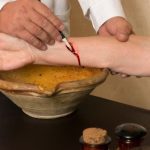 Music
Music  Music
Music  History
History 10 Less Than Jolly Events That Occurred on December 25
 Weird Stuff
Weird Stuff 10 Funny Ways That Researchers Overthink Christmas
 Politics
Politics 10 Political Scandals That Sent Crowds Into the Streets
 Weird Stuff
Weird Stuff Ten Bizarre Facts About The Doge Meme
 Our World
Our World 10 Ways Your Christmas Tree Is More Lit Than You Think
 Movies and TV
Movies and TV The 10 Coolest Stars to Set Sail on The Love Boat
 History
History 10 Things You Didn’t Know About the American National Anthem
 Technology
Technology Top 10 Everyday Tech Buzzwords That Hide a Darker Past
 Humans
Humans 10 Everyday Human Behaviors That Are Actually Survival Instincts
 Music
Music 10 Surprising Origin Stories of Your Favorite Holiday Songs
 History
History 10 Less Than Jolly Events That Occurred on December 25
 Weird Stuff
Weird Stuff 10 Funny Ways That Researchers Overthink Christmas
Who's Behind Listverse?

Jamie Frater
Head Editor
Jamie founded Listverse due to an insatiable desire to share fascinating, obscure, and bizarre facts. He has been a guest speaker on numerous national radio and television stations and is a five time published author.
More About Us Politics
Politics 10 Political Scandals That Sent Crowds Into the Streets
 Weird Stuff
Weird Stuff Ten Bizarre Facts About The Doge Meme
 Our World
Our World 10 Ways Your Christmas Tree Is More Lit Than You Think
 Movies and TV
Movies and TV The 10 Coolest Stars to Set Sail on The Love Boat
 History
History 10 Things You Didn’t Know About the American National Anthem
 Technology
Technology Top 10 Everyday Tech Buzzwords That Hide a Darker Past
 Humans
Humans 10 Everyday Human Behaviors That Are Actually Survival Instincts
10 Strange Facts about Humans and Horses You Will Hardly Believe
Dogs might be man’s best friend, but another place on the podium must surely go to horses. It is hard to argue that any other animal has helped humanity advance as much as them. For around 5,000 years, horses have helped people move heavier payloads over longer distances in a much shorter time than they could by themselves. Horses were also widely used in warfare, hunting, and sports; it is really only in the last couple of centuries, following the invention of the steam engine, that their role in society has been reduced.
With such a long history together, humans and horses have, of course, shared some fascinating and downright weird moments. From thinking that horses were gifts from the gods to having them answer emails, here are ten moments from the history of humans and horses that you will hardly believe.
Related: Top 10 Mysterious Archaeological Discoveries That Still Baffle Scientists
10 Gifts from the Gods
As the trident-wielding god of the sea, it is strange that Poseidon should also be linked to a land mammal. Yet the ancient Greeks believed that Poseidon was also the god of horses and the being who had bestowed them upon the world. To them, horses were literally a gift from the gods. In fact, not only did they believe that he was responsible for real horses, but he was also the father of many great horses in Greek mythology.
The talking horse Arion was the product of Poseidon’s pursuit of Demeter, the goddess of agriculture (and also his sister). Demeter transformed into a mare and hid herself among herds of horses to avoid him, but Poseidon discovered what she had done and transformed into a stallion. He was also the father of Pegasus, the famous winged horse. He gave immortal horses as a wedding gift to Peleus, the father of Achilles.
As for why the sea god should also be the god of horses, it should be remembered that Greek gods were not always given their domains based on their abilities or any other real reason. Poseidon was given the seas after drawing lots with his brothers.[1]
9 Horses of Different Colors
Long before the Greeks were writing about fictional horses, early humans were drawing them. At least, that is what scientists thought for a long time. The leopard-spotted horses found in 25,000-year-old cave paintings in France were initially thought to be figments of their prehistoric artists’ imaginations. Stone-age illustrators certainly knew what horses were, but DNA analyses suggested that only black or bay (reddish-brown) horses existed at the time. One theory was that the imaginary spotted horses might have been drawn for religious reasons.
However, a 2011 analysis of 31 horse fossils from across Europe found that six of them contained a genetic mutation, which is also found in modern spotted horses. This meant that what the cave people had painted was what they had really seen, and this could also mean that other cave paintings are more realistic than had been assumed. They might then be a reliable way to learn about life before written records began. Still, the question of why so many cave paintings of horses exist has yet to be conclusively answered.[2]
8 Medieval Europe “Supercars”
Cavemen painted a lot of horses. It might be fair to say they were a bit obsessed with them, but perhaps not as obsessed as people would become once they had domesticated them. In medieval England, for example, horses had the same kind of status as supercars today. According to research published in 2024, the Ferrari, Porsche, and Mustang logos might actually depict what their powerful cars have replaced.
The scientists analyzed the teeth of horses found in a medieval animal cemetery in Westminster, England, where some of the most physically impressive horses of the time were buried. They were looking to see where the horses came from and discovered that they came from all over Europe. Some were from Scandinavia, the Alps, Spain, and Italy, and the evidence suggested that they had been bred at royal stud farms.
What this means is that medieval elites likely sought out and imported the biggest and most powerful horses, just like modern elites might do with German or Italian sports cars. Big horses were a status symbol but also gave them an advantage in sports such as jousting.[3]
7 Revenge of a Persian King
There are plenty of tales of horse obsession that predate medieval times. When it comes to the ancients, the obvious choice is Caligula. He is often said to have made his favorite horse consul, although this is not true. However, several centuries before the infamous emperor lived, another ancient leader had a fondness for horses. This was the Persian king Cyrus, who, around 500 years earlier, was marching his army toward Babylon.
According to the ancient historian Herodotus, along the way, Cyrus’s army needed to cross the river Gyndes. It was only a tributary but was still large enough that it needed a boat to cross. However, when they reached the riverbank, one of Cyrus’s sacred white horses tried to cross on its own. The poor animal was swept away, causing Cyrus to become so angry he swore to make the river weak enough that women could cross it without getting their knees wet. He postponed his plan to invade Babylon and ordered his army to dig 180 channels on each side of the river. They succeeded in weakening it, but it cost them the whole summer.[4]
6 High Status in Ancient African Societies
Stories and myths can tell historians a lot about the role of horses in ancient societies, but there is some hard evidence, too. For example, in 2011, the skeleton of a horse that lived around 3,000 years ago was discovered in Africa, buried inside the kind of tomb that would normally have been reserved for people of high status. It was found in what used to be the kingdom of Nubia, a rival of ancient Egypt. This tomb had a chapel and pyramid above ground and several burial chambers that descended underground, along with a shaft to access them.
Around 200 people and their belongings were also buried inside, but there were very few animals apart from the horse. This suggests that it was very important to its owners. It was likely a chariot-pulling horse, but scientists found that it was cared for and lived a fairly long life.
In the centuries that followed, formal horse burials would become more common in the region. However, this reverential burial suggests that horses were already symbols of wealth and power among the Nubian people.[5]
5 Horse DUIs?
Elsewhere on the ancient African continent, a tragic combination of horses, wine, and teenage hijinks resulted in the burial of a famous young pharaoh. That is according to a theory put forward by an Egyptologist called Sofia Aziz. The exact cause of young King Tutankhamun’s death is a mystery, but one clue is a leg fracture he had. Aziz claims that the evidence points to a high-speed chariot crash, which might have happened because the king was drunk.
Egyptians were buried with things they wanted to bring with them after death, and Tutankhamun was buried with lots of dry white wine and six chariots. This suggests that these were some of his favorite things. However, earlier research suggests that he could not have driven a chariot because he had a clubbed foot, but Aziz thinks that could have been caused by his mummification. Studies have shown that teenagers are involved in most road accidents in modern times, and Aziz argues that this was probably no different when horses were pulling chariots around ancient Egypt.[6]
4 Horse Dentistry
One could not write about the history of horses and humans without mentioning the Mongolians, but their love of horses long predates Genghis Khan’s band of fearsome horse-riding warriors. Over one thousand years before the Mongol Empire, the people of the nomadic Deer Stone-Khirigsuur culture roamed the grasslands on horseback. But when they were not riding (or sacrificing) their horses, they were busy pioneering horse dentistry.
Horse skulls buried in the region and dated to the time of the Deer Stone-Khirigsuur culture—1300 BC to 700 BC—were found to have their wolf teeth removed. The wolf tooth is a spare tooth that emerges in the first year of a horse’s life but usually falls out by the third. If it does not, it can damage the mouths of horses wearing a metal bit and cause them pain. Metal bits started to be used in Mongolia around 800 BC, and they gave riders a greater degree of control over horses than existing bits made from materials like leather and wood. They were likely adopted by the Deer Stone-Khirigsuur people, which might explain why they started removing the wolf teeth of their horses.[7]
3 Burying Horse Skulls Beneath Irish Homes
The grasslands of Mongolia are not the only place where plenty of horse skulls can be found. Many can also be found in Ireland, but rather than digging up fields, one ought to look beneath the floorboards of an old house. The reasons for the spooky practice are not entirely clear, but researchers have a few theories. Some relate, rather obviously, to superstition.
The horse skulls could have been buried for luck, but other experts suggest that the practice stems from the belief that horses can see ghosts and evil spirits. Burying or hiding things that are said to ward off evil spirits has been practiced in several places around the world in the past. However, another theory is that the horse skulls enhanced the echo inside the house. This was important during social gatherings because it improved the sound of dancing feet.
Sometimes, the skull would be stuffed with coins for this purpose, too. Elsewhere in Ireland, skulls are said to have been buried below church altars because their acoustic qualities helped priests’ voices to be heard all around the church.[8]
2 The Power of Horse Power
While many people use horsepower today to measure and compare the power of vehicles, few are aware of its origins. It was conceived by James Watt—whose name was later confusingly attached to a different unit of power. He devised it to help him market his new steam engine in the 1770s. Many of the tasks his engine could do were done at the time by horses, so he figured that potential customers would understand him better if he explained its power in terms of how many horses it would take to achieve a similar result.
There are different theories about how he standardized the power of a horse, but the more interesting fact is that he had an incentive to overstate it. The better he made horses look, the better his machine would seem in comparison when it beat them at the same task. It appears he did exaggerate, but only a little. It is estimated that a typical horse can only actually sustain one horsepower for three hours, not an entire working day. However, the measurement worked to convince Watt’s customers, and his steam engine was a success.[9]
1 OutHorse Your Email
The steam engine was pretty much the beginning of the end for the close relationship between horses and people. Machines were more powerful, and they did not need feeding. Many of the roles previously filled by horses were taken over, but that is not to say there are no cases where horses and technology have worked together.
One recent and rather eccentric example comes from Iceland, which, in 2022, started offering a service where its horses would respond to people’s emails. The campaign was called “OutHorse Your Email,” and it was designed to promote tourism by letting visitors to the country enjoy their vacation free from the hassle of responding to pesky work emails. All they had to do was pick which horse they wanted to reply on their behalf, and it would compose a unique—albeit incoherent—message by trotting up and down a giant keyboard.[10]








